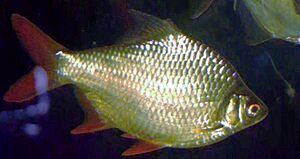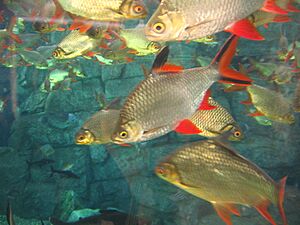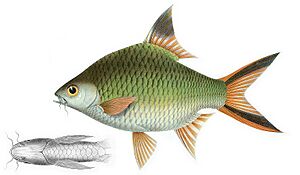Tinfoil barb facts for kids
Quick facts for kids Tinfoil barb |
|
|---|---|
 |
|
| Conservation status | |
| Scientific classification | |
| Synonyms | |
|
Barbodes schwanefeldii (lapsus) |

The tinfoil barb (Barbonymus schwanenfeldii) is a cool freshwater fish from Southeast Asia. It lives in warm, tropical waters. This fish belongs to the family called Cyprinidae, which includes many well-known fish like carp.
This fish was first described in 1853 by a scientist named Pieter Bleeker. Over time, its scientific name has changed a few times, but today it is usually known as Barbonymus schwanenfeldii. Sometimes, people even misspell its name!
Contents
What Does a Tinfoil Barb Look Like?
Tinfoil barbs are easy to spot because of their shiny, silvery bodies. They can also look golden yellow. These fish have bright red fins that make them stand out.
- Their top fin (dorsal fin) is red with a black spot at the very tip.
- The fins on their sides and belly are also red.
- Their tail fin is orange or blood-red. It has a white edge and a black stripe along each part.
These fish can grow quite large, up to 14 inches (35 cm) long! They can live for a long time too, usually between 10 and 15 years.
Where Do Tinfoil Barbs Live?
Tinfoil barbs come from rivers and streams in countries like Thailand, Cambodia, Laos, and Vietnam. You can also find them on islands like Sumatra and Borneo, and in the Malayan peninsula.
They live in different kinds of water, including rivers, canals, and even flooded fields. These fish like water that is slightly acidic to neutral, with a temperature between 72 and 77°F (22–25°C).
What Do Tinfoil Barbs Eat?
Tinfoil barbs are mostly plant-eaters. They enjoy munching on water plants and algae. Sometimes, they also eat insects, small fish, worms, and tiny crustaceans. They are not picky eaters!
Why Are Tinfoil Barbs Important?
Tinfoil barbs are important for a few reasons:
- Aquarium Trade: Many people buy them to keep as pets in large aquariums.
- Food Source: They are sometimes raised for food in fish farms.
- Bait: Occasionally, they are used as bait for catching other fish.
They are often sold fresh in markets.
How Do Tinfoil Barbs Reproduce?
It's hard to tell the difference between male and female tinfoil barbs just by looking at them. When they reproduce, the female fish scatters thousands of eggs. This is called "egg scattering."
Because they grow so big, tinfoil barbs are not often bred in home aquariums. It takes a lot of space to raise them!
Tinfoil Barbs in Your Aquarium
If you want to keep tinfoil barbs as pets, here are some things to know:
- Schooling Fish: They are social fish and like to live in groups with other tinfoil barbs.
- Water Flow: They prefer tanks with strong water currents, similar to their natural homes.
- Tank Mates: It's best to keep them with fish that are similar in size or even larger. They can be very active!
- Tank Size: Young tinfoil barbs are small, but they grow very quickly. Make sure you have a very large aquarium ready for them. Many people buy them when they are small and don't realize how big they will get.
- Behavior: Tinfoil barbs are generally peaceful. They spend most of their time swimming in the middle or bottom parts of the tank.
- Feeding: They are very eager eaters! They will try to eat as much food as they can during meal times. In an aquarium, they will eat almost any fish food you give them.
See also
- List of freshwater aquarium fish species



